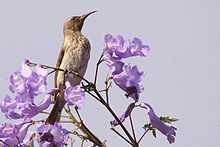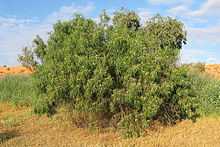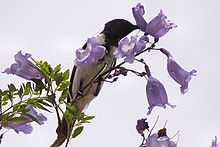Black Honeyeater
| Black Honeyeater | |
|---|---|
 | |
| A male on a Jacaranda | |
| Conservation status | |
| Scientific classification | |
| Kingdom: | Animalia |
| Phylum: | Chordata |
| Class: | Aves |
| Order: | Passeriformes |
| Family: | Meliphagidae |
| Genus: | Sugomel Mathews, 1922 |
| Species: | S. niger |
| Binomial name | |
| Sugomel nigrum (Gould, 1838) | |
| Synonyms | |
|
Myzomela nigra Gould, 1838 | |
The Black Honeyeater (Sugomel nigrum) is a species of bird in the family of honeyeaters, Meliphagidae, and the sole species in the genus Sugomel. The Black Honeyeater exhibits sexual dimorphism with the male being black and white while the female is a speckled grey-brown; immature birds look like the female. The species is endemic to Australia, and ranges widely across the arid areas of the continent, through open woodland and shrubland, particularly in areas where the emu bush and related species occur.
Black Honeyeaters feed on nectar, and have a long curved bill to reach the base of tubular flowers such as those of the emu bush. They also take insects on the wing, and regularly eat charcoal left behind at campfires. The male engages in a soaring song flight in the mating season, but contributes little to nest building and incubation. Both sexes feed and care for the young. While the population appears to be decreasing, they are sufficiently numerous and widespread to be considered of Least Concern in terms of conservation.
Taxonomy
The Black Honeyeater was first described by John Gould in 1838 as Myzomela nigra, using the Latin adjective niger to refer to the black plumage of the male. The genus name was derived from the Ancient Greek words myzo 'to suckle' and meli 'honey', and referred to the bird's nectivorous habits.[1] In 1967 ornithologist Finn Salomonsen transferred the species from Myzomela to the genus Certhionyx, which also contained the Banded Honeyeater (Certhionyx pectoralis) and Pied Honeyeater (Certhionyx variegatus), and later authorities accepted this classification.[2] However in 2004 genetic study of nuclear and mitochondrial DNA of honeyeaters resolved it as in a natural group with Myzomela after all, although it was an early offshoot and quite divergent genetically.[3] It was subsequently reclassified in its own genus Sugomel.[4] It is identified as Sugomel niger by most taxonomic authorities, and Sugomel nigrum by the IOC Birdlist.[5]
DNA analysis has shown honeyeaters to be related to the Pardalotidae (pardalotes), Acanthizidae (Australian warblers, scrubwrens, thornbills, etc.), and the Maluridae (Australian fairy-wrens) in a large Meliphagoidea superfamily.[6] The Papuan Black Myzomela, (Myzomela nigrita), found in Indonesia and Papua New Guinea is also known as the Black Honeyeater. It is a different but related species.[5]
Description

The Black Honeyeater is a small honeyeater with a long slender down-curved bill, a small rounded head and slender neck set on a plump body, and a short, slightly cleft tail.[7] It has relatively long, pointed wings compared with other Meliphagidae,[8] and very long wings for such a small bird, the development of which has been attributed to its feeding behaviour of flying between shrubs and hovering over flowers.[9]
The species is strongly sexually dimorphic.[8] Adult males are black and white, with a black head, neck, wings and upperparts, and a black stripe running down from the centre of the chest to the abdomen, and with a white belly, flanks and under-tail coverts. The female’s crown, ear coverts and upper parts are buff brown, scalloped paler, with a pale eyebrow, and the chest is speckled grey-brown grading into a dull white belly. In both male and female the iris is dark brown and the bill and legs blackish brown. Immature birds are similar to the adult female, however the upper breast and throat tend to be more uniform and the base of the bill is paler.[10] Immature birds are not separable from adults at a distance.[7]
The Black Honeyeater is quiet outside the breeding season, but calls before and during nesting, often early in the morning.[7] The calls include a soft metallic "chwit, chwit"; a louder note, a "tieee", with a monotonously even pitch and spacing at intervals of several seconds; and a weak "peeee", usually uttered by breeding males.[10] In high song flights the males give a double noted "tieee-tieee".[11] A soft scolding call is given by both sexes after the young hatch, which may be a food call for the young.[7] The species is also heard making a bill snap when hawking insects.[7] It is constantly on the move, hovering and hawking when feeding, and constantly chasing intruders at food sources.[8] Gould described its flight as "remarkably quick, and performed with zigzag starts".[8]
Distribution and habitat

The Black Honeyeater is a bird of the dry inland of Australia, being generally widespread if scattered in western Queensland and New South Wales to the South Australian border and occasionally recorded in the Victorian Mallee and Wimmera regions. In South Australia, it occurs in the south-east and it is widespread in the central and northern regions of Western Australia, with some rare records in the south near Kalgoorlie. In the Northern Territory it is widespread around Alice Springs, with some vagrants to the Top End.[11]
It is dependent on the presence of the emu bush Eremophila longifolia and related species.[12] As a result, the Black Honeyeater is found in open woodlands and shrublands of arid and semi-arid regions, as well as in mulga or mallee woodlands, and it will also be found in spinifex savanna where flowering shrubs such as grevilleas and paperbarks occur. It has been noted that the Black Honeyeater is able to locate emu bushes, even when clumps consisted of only two or three trees and were separated by many miles of country, which suggests the importance of this plant-bird association.[13]
The Black Honeyeaters is considered to be migratory rather than nomadic, with regular seasonal movements related to flowering of food plants, especially the emu bush. Some movements are southwards in spring and summer, moving northwards again in autumn and winter.[10] During severe droughts it has been recorded south of Bendigo and in the Hunter Region.[14] Irruptions (sudden population increases) can occur in some areas after rain or the movement of floodwaters.[11]
Behaviour
Food and feeding

The Black Honeyeater feeds on nectar, probing flowers and foliage with its long fine bill. It is mainly found in the crowns of eucalypts, at clumps of mistletoe or in shrubs, especially emu bushes Eremophila. Observations over a twelve-month period in South Australia recorded Black Honeyeaters visiting the flowers of Eremophila longifolia, Eremophila oppositifolia, Eucalyptus incrassata, and Grevillea ilicifolia. They were also frequently observed hawking for small insects.[9] The Black Honeyeater hovers briefly around flowers when feeding.[15] Normally found alone, in pairs or in small flocks, they may sometimes form large mixed flocks at food sources, associating with other birds such as Pied Honeyeaters and White-browed Woodswallows. Like many other honeyeaters, the Black Honeyeater catches insects on the wing.[10] The male, in particular, will rise to a height of 15 metres (49 ft) to seize an insect in mid-air, and then drop to a regularly used perch.[14]
A study of Black Honeyeaters at seven sites in Western Australia regularly recorded breeding females eating ash from the campsite fires and often making repeated visits over a brief period of time.[8] It was noted that the birds seemed attracted to the remote campfire with groups of around six hovering around and landing beside the fire, an activity described as similar to "bees buzzing around a honeypot."[8] After pecking at the ash, some of the females foraged for insects, sallying from the foliage of nearby Wheatbelt Wandoo (Eucalyptus capillosa) before returning for more ash.[8] The activity of the females approaching the fire ranged from a single peck to sustained feeding for a minute or more. Male birds occasionally landed near the fire, but none were seen to take ash.[8] Well developed brood patches on the birds mist netted near the fires, suggest that the females take ash around the time of laying, and throughout the incubation and feeding period. Wood ash is rich in calcium and it was hypothesised that the females were eating ash to form medullary bone before egg-laying or to repair a calcium deficit after laying.[8] When other small birds, such as American hummingbirds, were recorded eating calcium-rich ash, bones or shell it was suggested that the bones of small species may not be able to store enough calcium for egg production.[16]
Breeding
The breeding season is from July to December (mostly between August and November), or opportunistically after rain. There is apparently some variation based upon location, with birds in West Australia breeding earlier and breeding in March in Queensland.[17] Black Honeyeater populations concentrate for breeding wherever the right plants are in flower and there is an abundance of insects, essential for feeding the young.[18] At the beginning of the mating season, males can be seen soaring in "song flights" which consist of a series of zigzagging movements, high into the air, accompanied by constant calling. The birds appear to stiffen themselves, with wings pointed downward, as they rise, while uttering a two-note call.[10]
Breeding pairs of Black Honeyeaters will nest in groups or loose colonies, with males aggressively defending a small breeding territory against members of their own species as well as other honeyeaters. Both members of the pair seem to be involved in selecting the nest site.[7] The nest is usually situated low on a dead limb or in a fork of a small tree or shrub,[10] though sometimes fallen timber including a fallen Callitris pine is chosen as the nest site.[7] The female gathers nesting material close to the nest site, while the male is engaged in song flights,[10] and she builds the shallow, open, cup-shaped nest from fine twigs, grass, and other plant material bound with spiderweb, lining it with grass, roots, fibre, horse hair, flowers or wool.[11] As the young grow the nest can become flattened to a saucer shape, and may be an almost flat platform by the time the chicks fledge.[14]
The female lays two to three eggs that are 15 millimetres (0.59 in) long, 12 millimetres (0.47 in) wide and an unusual swollen oval shape. The eggs are slightly lustrous, buffy white in colour and dotted with reddish-brown and grey blotches that often appear in a cloud over the larger end of the eggs.[19] Black Honeyeater nests are occasionally parasitised by Horsfield's Bronze Cuckoo.[10] The female incubates alone, leaving the eggs exposed for short periods during the day to take insects on the wing.[10] When approached, the sitting bird attempts to hide by sinking into the nest and, if unsuccessful in deterring the intruder, will tumble to the ground with outstretched wings, giving weak calls in an effort to lure the intruder away from the nest.[14]
While the female is incubating, the male remains on guard at one of several regular vantage points. The incubation period is around sixteen days, and the fledging period approximately eighteen days.[10] On hatching, the young birds' eyes are closed, and they are naked except for tufts of down on the head, nape and back.[14] Both sexes feed and care for the young,[11] taking all of the insects for the young birds on the wing.[10] At one nest, two small young were fed every ten minutes or so, with the male bringing food three to four times more often than the female.[7]
Conservation status
The Black Honeyeater may be adversely affected by the loss of the emu bush to grazing and weed control by farmers.[11] Despite the fact that the population trend appears to be decreasing, the decline is not believed to be particularly rapid; the current population seems to be of sufficient numbers, and the species has a sufficiently large range, for the species to be evaluated as of Least Concern.[20]
References
- ↑ Liddell, Henry George; Scott, Robert (1980) [1871]. A Greek-English Lexicon (Abridged Edition). Oxford, United Kingdom: Oxford University Press. pp. 272, 374. ISBN 0-19-910207-4.
- ↑ Keast, Allen (1985). "An Introductory Ecological Biogeography of the Australo-Pacific Meliphagidae". New Zealand Journal of Zoology 12 (4): 605–22. ISSN 0301-4223.
- ↑ Driskell, A. C.; Christidis, L. (2004). "Phylogeny and evolution of the Australo-Papuan honeyeaters (Passeriformes, Meliphagidae)". Molecular Phylogenetics and Evolution 31 (3): 943–60. doi:10.1016/j.ympev.2003.10.017. PMID 15120392..
- ↑ Christidis, Les; Boles, Walter E. (2008). Systematics and Taxonomy of Australian Birds. Canberra: CSIRO Publishing. pp. 187–91. ISBN 978-0-643-06511-6.
- ↑ 5.0 5.1 Lepage, Denis (2011). "Black Honeyeater (Certhionyx niger) Siebers, 1928". Avibase: The World Bird Database. Bird Studies Canada. Retrieved 27 December 2010.
- ↑ Barker, F. K.; Cibois, A.; Schikler, P.; Feinstein, J. & Cracraft, J. (2004). "Phylogeny and diversification of the largest avian radiation". PNAS 101 (30): 11040–45. doi:10.1073/pnas.0401892101. PMC 503738. PMID 15263073..
- ↑ 7.0 7.1 7.2 7.3 7.4 7.5 7.6 7.7 Higgins, P.J; Peter, J.M. and Steele, W.K. (2001). Handbook of Australian, New Zealand and Antarctic Birds V 5. Oxford, UK: Oxford University Press. pp. 1133–43. ISBN 0-19-553258-9.
- ↑ 8.0 8.1 8.2 8.3 8.4 8.5 8.6 8.7 8.8 Brooker, Michael G.; Cale, Belinda M (December 2010). "Some notes on the Black Honeyeater Sugomel niger in Western Australia, with Special Reference to Feeding on Ash". Australian Field Ornithology (Bird Observation & Conservation Australia) 27 (4): 153–158. ISSN 1448-0107.
- ↑ 9.0 9.1 Ford, Hugh A. (July 1978). "The Black Honeyeater: Nomad or Migrant?". South Australian Ornithologist (South Australian Ornithological Association) 27: 263–9. ISSN 0038-2973.
- ↑ 10.0 10.1 10.2 10.3 10.4 10.5 10.6 10.7 10.8 10.9 10.10 Longmore, Wayne (1991). Honeyeaters and their Allies of Australia. North Ryde, NSW: Harper Collins. pp. 313–6. ISBN 0-207-15444-9.
- ↑ 11.0 11.1 11.2 11.3 11.4 11.5 "Black Honeyeater". Birds in Backyards. Birds Australia, Australian Museum. 19 February 2007. Archived from the original on 3 May 2010. Retrieved 16 May 2010.
- ↑ Gannon, G.R. (March 1966). "The Influence of Habitat on the Distribution of Australian Birds". The Emu (Royal Australasian Ornithologists Union) 65 (4): 241–53. doi:10.1071/MU965241. ISSN 0158-4197.
- ↑ Hobbs, J.N. (1958). "Association Between the Black Honeyeater and the Emu Bush". The Emu (Royal Australasian Ornithologists Union) 58 (1): 127–129. doi:10.1071/MU958127. ISSN 0158-4197.
- ↑ 14.0 14.1 14.2 14.3 14.4 Milne, Hugh V. (1938). "The Black Honeyeater". The Emu (Royal Australasian Ornithologists Union) 37 (4): 277–80. ISSN 0158-4197.
- ↑ Morcombe, Michael (2000). Field Guide to Australian Birds. Queensland, Australia: Steve Parish Publishing. pp. 268–9. ISBN 1-876282-10-X.
- ↑ Adam, Michael D.; des Lauriers, James R. (Spring 1998). "Observations of Hummingbirds Ingesting Mineral-Rich Compounds". Journal of Field Ornithology 69 (2): 257–61. JSTOR 4514314.
- ↑ Higgins, Peter; Christidis, Les; Ford, Hugh (2008). "Family Meliphagidae (Honeyeaters)". In del Hoyo, Josep; Elliott, Andrew; Christie, David. Handbook of the Birds of the World. Volume 13, Penduline-tits to Shrikes. Barcelona: Lynx Edicions. pp. 636–7. ISBN 978-84-96553-45-3
- ↑ Keast, A. (1967). "Seasonal movements in the Australian honeyeaters (Meliphagidae) and their ecological significance". Emu (The Royal Australasian Ornithologists´ Union) 67 (3): 159–209. doi:10.1071/MU967159.
- ↑ Beruldsen, Gordon R. (2003) [1980]. A Field Guide to Nests and Eggs of Australian Birds. Kenmore Hills, Qld: self. p. 389. ISBN 0-646-42798-9.
- ↑ BirdLife International (2009). "Species factsheet: Certhionyx niger". Retrieved 15 May 2009.
External links
| Wikimedia Commons has media related to Certhionyx niger. |
- Certhionyx niger (Black Honeyeater) IUCN Red List of Threatened Species Downloaded on 6 September 2011.
